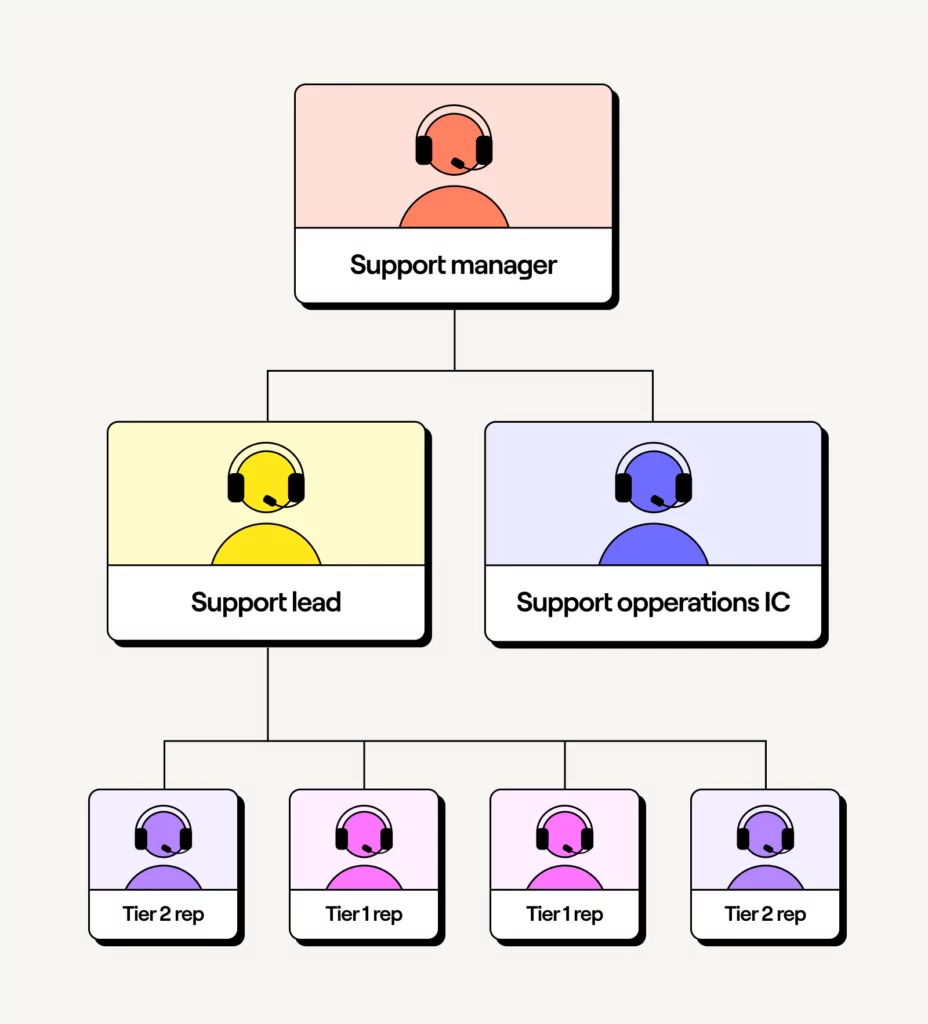“Structure” is not a term you hear often in small businesses and startups – but it’s essential for growing a customer service team. Customer service folks stand at the front lines of the customer experience, offering their support and acting as the face of the brand, so consistency and quality are always top priorities for us at OpenPhone.
Not only that, but the customer service team is the heart of a business — the people who best understand customer needs. Without solid customer support, customer retention is low and churn is high.
When you’re just creating a customer service department, it’s hard to know where to start with organizational structure. Or you decide on a team structure that works for you, but doesn’t actually account for what your customer needs from you.
As the VP of Customer Service at OpenPhone, I’ve encountered many of the challenges and benefits that come with implementing a customer service structure.
Here, I’ll share some of my thoughts on how to build a customer service team, and the decision-making that goes into it. I’ll discuss designing service and support teams around customer needs, how to think about adding headcount and layers of hierarchy, and what to look for in new team members.
1. Identify your target issues and ideal channels
Before deciding on the type of structure you want and choosing the roles and responsibilities of team members, focus on the team’s core objectives.
Ask yourself: What are we trying to solve for?
You can answer this question by understanding:
- The top critical issues your customers are facing
- How quickly these issues need to be solved based on customer feedback and data
Once you’ve pinpointed high-priority issues, you then need to figure out what are some of the best channels that you can use to solve those pain points and communicate solutions to the customer.
By focusing narrowly on high-priority pain points, you can quickly reduce inefficiencies in the customer journey and show your progress to leadership.
Start with email as your first channel
Email is the easiest customer-facing channel to manage because you can state upfront what your SLA (service-level agreement) will be for the customer. In your email header and/or signature, you can manage customer expectations by introducing yourself and stating exactly how you operate. This will build trust from the get-go.
Customers expect longer response times via email as opposed to the immediacy of social media or chatbots. The expanded timeline gives your customer support team room for troubleshooting issues as they come in.
If you’re just starting out with a support function, or only have one customer service representative, you won’t have prepared answers for all your customers. Better customer service develops over time, as customer service representatives start to see more use cases and field repeat questions. As you answer questions and refine your policies, you can build out an internal knowledge base to help your team respond to support inquiries more efficiently.
Already within step one, you have a directive to guide you (priority pain points) and a channel (email) to set up.
2. Add headcount and layers based on volume
Once you’ve kicked off your customer service function, you can start thinking about hiring and who they report to.
One thing is true for all customer success leaders, no matter how fast the business is growing: your support team’s structure entirely depends on your support volume.
In the early days of OpenPhone, our founders answered every single email because they had the bandwidth to do so. As we’ve scaled, our support function scaled and we’ve added team members and layers to accommodate that.
If you sell a product or service that requires some technical expertise, it’s a good idea to tier your support agents. For instance:
- Tier 1 support can focus on non-technical customer issues and questions, such as answering how-tos for new customers, handling requests for refunds or exchanges, and communicating with customers experiencing a delay in service.
- Tier 2 is technical support, sometimes including support engineers, who tackle more complicated technical bugs that slow down or interrupt service.
With or without those tiers you should add team leads as you grow. Team leads are junior managers with lots of customer-facing experience. They coach junior customer service representatives and assess their performance while gaining experience in leadership. The support lead function is a good stepping stone to building your team out as you scale.
At some point, your team will need strategic planning, process improvements, learning and development, and cross-functional alignment, at which point you’ll need a department-level customer support manager for the team.
Depending on your support ticket volume and the importance of service to your business, you might also need to adjust the organization structure to include functions that work alongside the support team, such as an operations manager who focuses on eliminating friction and inefficiency from the support customer journey. Support operations managers may act as individual contributors (IC) on smaller teams or also manage others as your department grows, having direct reports that manage larger initiatives such as onboarding new agents.
The addition or subtraction of just one role within a team can make the difference between good customer service and five-star customer service. With that in mind, here’s a visual representation of the roles we’ve discussed so far in an organizational chart:

3. Screen new hires for the right core competencies
You can’t scale your support team if you don’t hire the right people for each role. While each customer support rep and manager brings their own set of skills and personality to the role, there are positive signs you can look out for when hiring for your department.
Key core competencies for customer support reps
1. Solution-oriented – Look out for people who like to solve puzzles and dig into solutions in their environment.
2. Patient – Support is hard. Front line reps deal with a lot of negativity and a lot of issues every day, so you want to build your team around people who have lots of patience.
3. Empathetic – Customer service reps are personable and understanding. In their roles, they must be able to put themselves in the customer’s shoes and connect emotionally to solve problems and provide satisfactory service.
4. Growth mindset – Customer needs change often. The best service and support reps are people who value learning and learn a lesson from any situation, positive or negative.
Lastly, it helps if your customer support reps don’t act as lone wolves. These roles require a lot of teamwork, whether that’s within the customer service department, or cross-functionally with teams such as Sales, Marketing, and Engineering.
Key core competencies for managers
Managers may start out with the core competencies required of individual contributors, but customer service management has its own unique skillset. Many managers, including myself, learn this on the job. Here I’ve cultivated the top skills I see as contributing to success.
- Be a cheerleader – Being a leader in a customer experience organization means building a culture of positivity. Agents are taking their cues from you, so you have to amplify the wins and take extra steps to keep everyone motivated. When you’re dealing with problems every single day, it’s easy to get bogged down by negativity. Leaders need to ramp up the positive language and loud celebrations.
- Be a player/coach – CS leaders don’t just cheer from the sidelines, however. They actively get involved in the game. Leaders who can get up close and personal with the customer, but also step back and guide their team with strategic vision, are invaluable to a growing team built on trust and respect.
When hiring, keep in mind Tier 1 support roles are often entry-level jobs for agents. And people come to support roles from all backgrounds and experiences. You may have to dig into college or retail jobs, or even previous careers they have had in the past in order to identify their strengths and skills.
And if you’re hiring managers, in addition to understanding what their competencies are, try to understand their coaching framework, how they assess team performance, and what metrics they use to measure success.
All of this information can help you understand whether someone is the right fit for a role in your customer service organization.
4. Keep your tools and process simple
The first, and most comprehensive, CX tool you need for your team is a customer relationship management tool (CRM) to manage your customer communications and interaction history. When you’re just starting out and building your team, you can manage with just a CRM.
Starting out with too many tools can get you into trouble because when you start to scale the organization, customer data will be scattered everywhere. CS reps will be confused by the multiple sources of truth, and more likely to make errors when talking to customers.
Similarly, keep all processes for your team simple so that you don’t overload them with internal work. The one weekly meeting you can’t compromise on is a team check-in. In this meeting, go over:
- General mood and motivation levels around work
- The goals you had for the prior week, and how performance aligned with those goals.
- Specific challenges that team members are facing, and want to consult the team about
Plus, depending on your team’s size, 1:1s between managers and the reps they oversee; however, managers can set the cadence for these. 1:1s will only involve upper management when there’s an issue they need to address, or there’s a significant structural change.
5. Build a clear growth path for team members
If you’ve hired the right people in your team, they will grow personally as your business scales. Give them a clear growth path so that they know you’re invested in their career development.
For Tier 1 reps, the next step is usually moving into a Tier 2 role. From there, you can go in any number of directions. Common growth paths you can offer your reps include:
- CS Management: Reps can continue moving through levels of management within the customer service organization into lead roles.
- Specialized CX roles: Some reps can take on individual contributor (IC) roles in your team, like developing internal training documentation or building out new support channels like live chat.
- Engineering: Reps who are more technically inclined and enjoy the challenge of de-bugging systems, can move into a quality assurance (QA) role in the engineering team.
- Marketing: Reps who are more creatively inclined can produce help content for your team and then transition to your marketing team.
The customer experience arena is a great place to gain deep applied knowledge about the company and the product you’re working on. When you learn that, you realize support is a breeding ground for great talent across all areas of an organization.
Structure your team your way
Every team’s needs are different, so there isn’t a one-size-fits-all approach to structuring teams.
Whether your team has a product-based, divisional, market-based, circular structure or a matrix structure, focus on the ingredients you need for a productive team that is motivated by customer loyalty and success.By doing so, you’ll find a structure that works for you.
You can always take an iterative approach to developing your customer service department. You don’t have to get it right all at once, and experimentation is the only way to find out if your internal structure resonates externally, in customer interactions.
What matters most of all is to consistently solve major and minor issues for your customers and continue to adjust resources as business objectives and customer needs evolve.
If you’re looking to tackle how to resource around automations, check out this guide I’ve put together around customer service automations.

